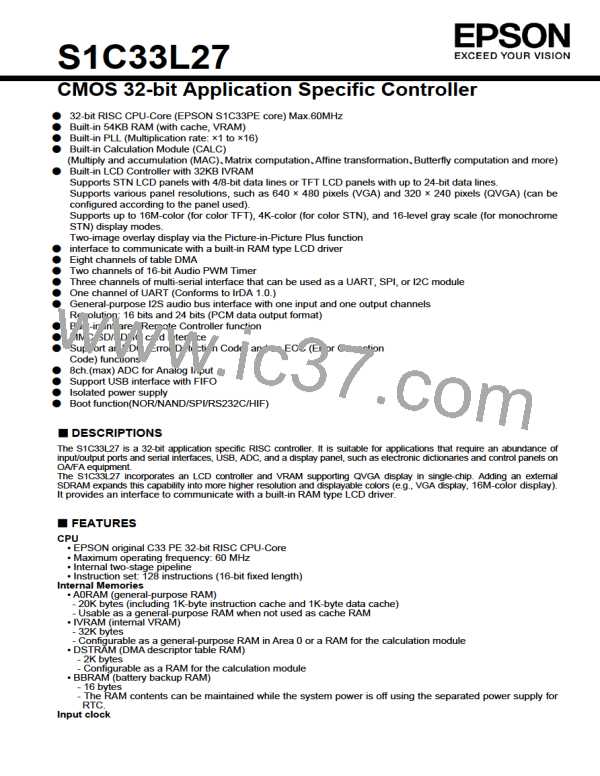S1C33L27
• High-speed clock (OSC3)
- Maximum input clock frequency: 48 MHz
- Generated by the oscillator circuit (using an external crystal or ceramic resonator) or an external clock is
input.
• Low-speed clock (OSC1)
- 32.768 kHz (typ.) clock for RTC and low-power operations
- Generated by the oscillator circuit (using an external crystal resonator) or an external clock is input.
Cache Controller (CCU)
• 1K-byte instruction cache and 1K-byte data cache that adopts a four-way associative method
• LRU replacement algorithm
• Automatic lock function during debug mode and the interrupt process of specified priority
• Write through function with a 1-word write buffer
DMA Controller (DMAC)
• Eight channels of table DMA
• Supports table reloading and low-priority channel pausing functions.
• 24 hardware trigger sources and 8 software trigger sources
SRAM Controller (SRAMC)
• Allows connection of SRAM, ROM, and Flash memories.
• 26-bit address bus and 8/16-bit selectable data bus
• Up to six chip enable signals are available to connect external devices.
• Up to 64M-byte (A[25:0]) address space can be accessible with each chip enable signal.
• Programmable bus access wait cycle (0 to 15 cycles)
• Little endian access
• Memory mapped I/O
• Supports both A0 and BS (Bus Strobe) type devices.
• Supports external wait request via the #WAIT pin.
SDRAM Controller (SDRAMC)
• Supports SDRAM interface.
• Supports only SDRAM devices with 8/16-bit data bus.
- Minimum configuration: 16M bits (2MB), 16-bit SDRAM × 1
- Maximum configuration: 512M bits (64MB), 16-bit SDRAM × 1
• CAS latency: one, two, or three programmable
• Supports two-burst read and single write operations.
• Equipped with a four-stage × 16-bit DQB (Data Queue Buffer).
• Supports up to four SDRAM banks and bank active mode.
• Built-in 12-bit auto-refresh counter
• Intelligent self-refresh function for low power operation
• Arbitrates external bus accesses by AHB-1 (CPU, DMAC, HIF) and AHB-2 (LCDC).
Host Processor Interface (HIF)
• 8- or 16-bit asynchronous parallel interface to control the S1C33L27 by an external host processor
• Provides semaphore registers.
Clock Management Unit/Oscillators/PLL (CMU)
• Selects the system clock source (OSC3, PLL, or OSC1).
• Turns the OSC3 and OSC1 oscillator circuits on and off.
• Controls frequency multiplication rate of the PLL (×1 to ×16).
• Controls clocks according to the standby mode (SLEEP and HALT).
• Controls the external clock.
• Controls clock supply to the core and peripheral modules.
• OSC3 oscillator circuit
- Crystal oscillation: 5 MHz min. to 48 MHz max.
- Ceramic oscillation: 5 MHz min. to 48 MHz max.
- External clock input: 2 MHz min. to 48 MHz max.
* A 48 MHz clock source with 0.25% of accuracy should be connected for using the USB function.
* Before using a ceramic resonator, please be sure to contact Murata Manufacturing Co., Ltd. for further
information on conditions of use for ceramic resonators.
• PLL
- PLL input frequency: 5 MHz min. to 48 MHz max. (OSC3 ×1, ×1/2, ×1/3, ... ×1/9, ×1/10)
- PLL output frequency: 20 MHz min. to 60 MHz max.
- Multiplication rate: ×1, ×2, ×3, ... ×15, ×16
• OSC1 oscillator circuit
- Crystal oscillation: 32.768 kHz typ.
- External clock input: 32.768 kHz typ.
Interrupt Controller (ITC)
• Five non-maskable interrupts
• 34 maskable interrupts (including four software exceptions)
16-bit Audio PWM Timer (T16P)
• Two channels of 16-bit timer/counter with PWM output function
• Three bit division modes are provided. (10 bits + 6 bits, 9 bits + 7 bits, 8 bits + 8 bits)
• Can support 8, 16, 22.05, 32, 44.1, and 48 kHz sampling rates.
2

 EPSON [ EPSON COMPANY ]
EPSON [ EPSON COMPANY ]